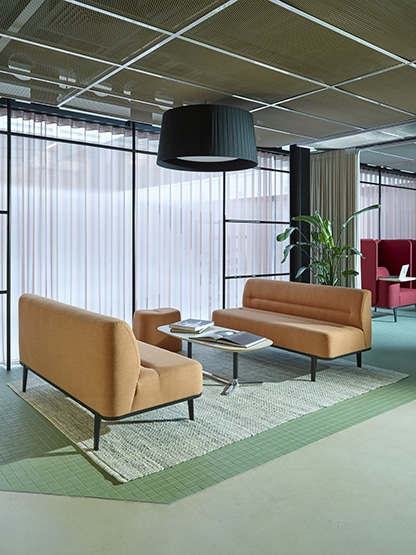In modern workplaces, the concept of collaborative work environments has gained significant traction. As organisations recognise the importance of fostering innovation and creativity, the design of office spaces has shifted towards creating environments that inspire collaboration and teamwork. One key element in this paradigm shift is the incorporation of creative breakout spaces—areas specifically designed to encourage spontaneous interactions and idea exchange among employees.
Understanding the Need for Collaborative Work Environments
Traditional office layouts often featured isolated cubicles and closed-door offices, hindering communication and collaboration. The realisation that innovation flourishes in environments that facilitate interaction and idea-sharing has led to a reimagining of office spaces. Collaborative work environments prioritise open layouts, shared spaces, and the integration of breakout areas that serve as catalysts for creativity.
Key Elements of Creative Breakout Spaces
- Flexible Furniture and Layouts
Creative breakout spaces are characterised by flexible furniture arrangements that can be easily reconfigured to suit different needs. This adaptability allows teams to customise their workspace based on the nature of their collaborative activities, promoting a dynamic and responsive environment. - Natural Elements and Comfortable Seating
Integrating natural elements, such as plants and ample natural light, creates a more inviting atmosphere. Comfortable seating options, like lounge chairs and bean bags, contribute to a relaxed setting that encourages informal discussions and brainstorming sessions. - Technology Integration
Equipping breakout spaces with modern technology, such as interactive displays and wireless connectivity, enables teams to seamlessly share ideas and collaborate on digital platforms. This integration fosters a tech-savvy environment that aligns with the digital age. - Varied Work Surfaces
Incorporating a mix of work surfaces, from standing desks to communal tables, allows for diverse work styles. Some individuals may prefer standing while brainstorming, while others may thrive in a more traditional seated setup. Providing options accommodates various preferences and encourages productivity. - Personalisation and Artistic Elements
Allowing employees to personalise their breakout spaces fosters a sense of ownership and belonging. Artistic elements, such as murals or vibrant decor, add a touch of creativity and inspiration to the surroundings.
Benefits of Creative Breakout Spaces:
- Enhanced Collaboration
By providing designated spaces for collaborative activities, organisations can enhance teamwork and idea generation. Breakout spaces serve as hubs for spontaneous discussions, fostering a culture of innovation. - Increased Employee Engagement
A well-designed collaborative environment contributes to higher employee satisfaction and engagement. When employees have access to inspiring breakout spaces, they are more likely to feel motivated and connected to their work. - Boosted Creativity and Problem-Solving
The informal and relaxed atmosphere of breakout spaces encourages creative thinking. These spaces become incubators for new ideas and innovative solutions as employees feel more liberated to express themselves in a less formal setting. - Adaptability to Remote Work
As remote work becomes increasingly prevalent, creative breakout spaces serve as vital components for hybrid work models. When employees return to the office, these spaces offer a valuable contrast to home-based work environments, promoting collaboration and team dynamics.
Designing collaborative workspace
Designing collaborative work environments with creative breakout spaces is an investment in the future of work. By prioritising spaces that encourage collaboration, organisations can unleash the full potential of their teams, fostering a culture of innovation and adaptability in an ever-evolving business landscape. As the workforce continues to evolve, so too must the spaces where we work, creating environments that inspire creativity, connectivity, and collective success.
Planning breakout spaces
Planning breakout spaces involves a thoughtful and strategic approach to creating environments that foster collaboration, creativity, and innovation. Here are key considerations in the planning process:
- Needs Assessment
Understand the specific needs and preferences of your workforce. Consider the nature of tasks performed, team dynamics, and the level of collaboration required. - Space Allocation
Identify suitable areas within the office for breakout spaces. Ensure they are easily accessible, well-connected to the main workspace, and have the capacity to accommodate various team sizes. - Furniture and Layout Design
Select flexible and ergonomic furniture that can be easily reconfigured. Create varied seating arrangements, incorporating options like lounge chairs, standing desks, and communal tables to cater to different work styles. - Technology Integration
Equip breakout spaces with modern technology, such as interactive displays, video conferencing tools, and wireless connectivity, to facilitate seamless digital collaboration. - Comfort and Aesthetics
Prioritise comfort with comfortable seating, natural lighting, and aesthetically pleasing decor. Create a welcoming atmosphere that encourages employees to use the breakout spaces for both work and relaxation. - Flexibility and Adaptability
Design breakout spaces with adaptability in mind. Ensure that furniture and layouts can be easily modified to accommodate various team activities and collaborative needs. - Branding and Personalisation
Consider incorporating elements of your company’s brand identity into the breakout spaces. Allow employees to personalise their areas, fostering a sense of ownership and connection to the workspace. - Noise Management
Implement measures to control noise levels, ensuring that breakout spaces strike a balance between a vibrant atmosphere and a productive work environment. Consider acoustic elements, such as rugs or sound-absorbing panels. - Accessibility and Inclusivity
Ensure that breakout spaces are accessible to all employees, including those with mobility challenges. Design spaces that promote inclusivity and cater to diverse preferences and needs. - Feedback and Iteration: Gather feedback from employees about the effectiveness of breakout spaces. Use this information to make iterative improvements and adjustments to enhance the overall functionality and usability of these collaborative environments.
By carefully considering these factors, organisations can create breakout spaces that not only meet the practical needs of their teams but also contribute to a positive and innovative work culture.

FAQs: Creative Breakout Spaces and Collaborative Work Environments
- What are creative breakout spaces? Creative breakout spaces are designated areas within an office designed to encourage spontaneous collaboration, brainstorming, and informal discussions among employees. These spaces are characterised by flexible furniture, technology integration, and a relaxed atmosphere.
- Why are creative breakout spaces important in the workplace? Creative breakout spaces play a crucial role in fostering innovation and collaboration. Organisations can enhance teamwork, creativity, and overall productivity by providing environments that support dynamic interactions and idea exchange.
- What elements make a breakout space creative? Creative breakout spaces incorporate flexible furniture, comfortable seating, natural elements, technology integration, varied work surfaces, and artistic elements. These elements contribute to a dynamic and inspiring atmosphere that stimulates creative thinking.
- How do creative breakout spaces contribute to collaboration? Creative breakout spaces provide employees with dedicated areas for spontaneous discussions and collaborative activities. These spaces break down traditional barriers, promoting open communication and facilitating teamwork among individuals and teams.
- Can creative breakout spaces be customised for different teams or activities? Yes, one of the key features of creative breakout spaces is their flexibility. Furniture and layouts can be easily reconfigured to suit the specific needs of different teams or collaborative activities, promoting adaptability and customisation.
- What role does technology play in creative breakout spaces? Technology is integrated into creative breakout spaces to facilitate digital collaboration. Interactive displays, wireless connectivity, and other modern tools enable teams to share ideas seamlessly and enhance the overall collaborative experience.
- How do creative breakout spaces contribute to employee engagement? Well-designed breakout spaces create a more inviting and enjoyable work environment. Increased engagement is a natural result, as employees find these spaces conducive to creative thinking, collaboration, and a sense of ownership in their workplace.
- Can creative breakout spaces accommodate various work styles? Yes, creative breakout spaces often feature a mix of work surfaces, from standing desks to communal tables, to cater to diverse work styles. This flexibility allows employees to choose the setting that best suits their preferences and enhances their productivity.
- Are creative breakout spaces only relevant in traditional office settings? No, creative breakout spaces are adaptable to various work environments, including remote and hybrid work setups. These spaces serve as valuable hubs for collaboration, whether employees are working in a traditional office or remotely.
- How do creative breakout spaces contribute to problem-solving and innovation? The informal and relaxed atmosphere of creative breakout spaces encourages creative thinking and idea generation. These spaces become hubs for innovation, as employees feel more liberated to express themselves and explore new ideas in a less formal setting.



